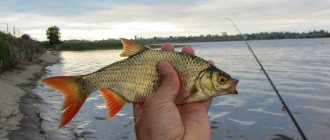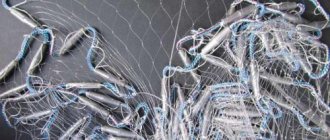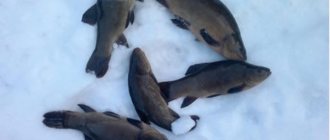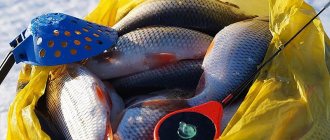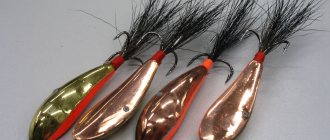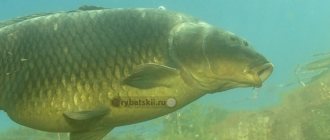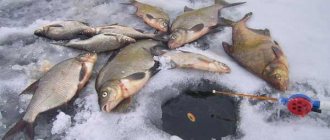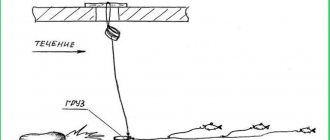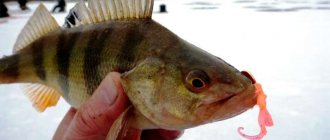Why is it necessary to cast nets in the winter cold?
Moreover, to be waist-deep in unfrozen water or in an already thawed river, and pull a seine. Are there not enough warm days? Let's try to figure this out too.
The Germans probably love this cold fishery very much, because in their language there are several names for it: eisangeln, eisfischen and unterseeangeln. In the meantime, watch the video - fishing with nets in winter.
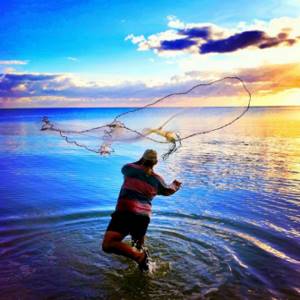
One more thing. Net fishing is not only strictly licensed, but is also under the watchful eye of numerous regulatory authorities.
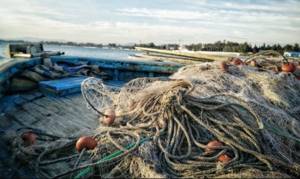
Whether you are an individual fisherman or a large fish farm. Just a citizen with a net of a couple of meters is already a potential violator of the Criminal Code of the Russian Federation, nicknamed a poacher.
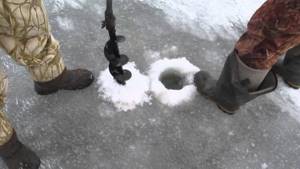
So who are they, winter fishermen with seines, if these are not the southern territories of Russia?
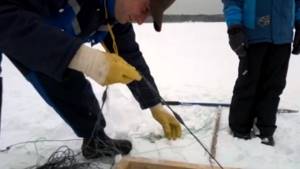
Someone in it should know more than others about the reservoir, its population of underwater fauna, where it is better to set up the seines, at what time of the day or at night, and many more rules that will ensure a rich catch.
Read here Spider-lift: how to make and fish with a spider. Step-by-step fishing instructions for beginners (105 photos + video)
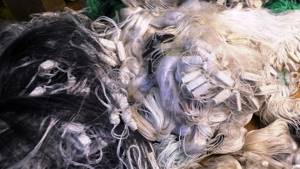
Fishnet
A fishing net is a fishing tool woven from threads, or a net fishing tool, used in fishing to catch fish in large quantities. There are two types of netting gear - enveloping and straining. Covering fishing gear.
- The principle of operation of a meshing net, usually called a fishing net or gill net, is based on the fact that the mesh is placed vertically in the path of the fish, which, trying to pass through the net, becomes entangled in the mesh - it becomes entangled.
- A fish caught in a net, if it is greater than the distance between the nodes of the net, becomes entangled in the mesh of the net with its gill covers, the more it tries to get out. Sampling fish from a gill net often involves certain difficulties associated with unraveling each individual fish from the mesh[1]. Straining fishing gear.
- The principle of operation of a straining fishing net is based on detaining (slinging) fish in a certain area of the water area with a relatively fine-mesh mesh, and filtering water through the mesh when removing the net with the catch to the shore or on board the vessel. At the same time, tethering the fish is extremely undesirable, as it makes it difficult to select entangled fish.
A large straining fishing net like this is usually called a seine. Small straining nets also include “spider” and delirium. A separate subgroup of straining nets includes a fishing trawl - a fishing gear in the form of a net bag towed by a vessel in the water column (pelagic or mid-water trawl) or along the surface of the ground (bottom trawl).
Source: https://videoyoutub.ru/watch/olu_6tSK_uQ
The basics of fishing at any time of the year
- In a large area of water, in its coastal zone, washed away by the waves, do not look for fish. Here is a hungry “table” for her: food is kept further away.
- Strengthen the network where debris is not noticeable. Place in open space, focusing on the bottom. The more bumpiness, pits, and other relief, the better.
- The mesh is installed near water thickets. This is where predatory fish live - pike, for example.
- Frost is not frost, but throw nets under the ice
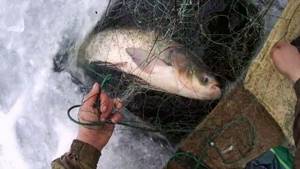
In winter, fish gather under the ice where there is a lot of underwater oxygen, especially springs and tributaries to rivers. Fishing in winter with nets under the ice is both a commercial activity and an outdoor recreation.
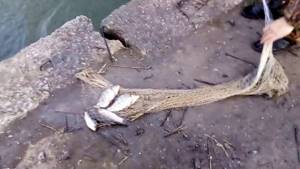
Experienced ichthyologists, and experienced fishermen, can easily find in which parts of the water area the ice is weaker and where gullies appear.
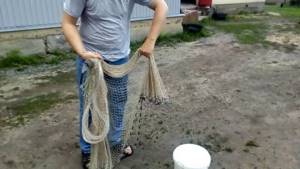
This is where net fishing on the river in winter will bring a big harvest. Winter fishing in Russia has been going on since the 19th century. Moreover, where there are very severe frosts, in Yakutia. And the wider the water area, the greater the fish catch.
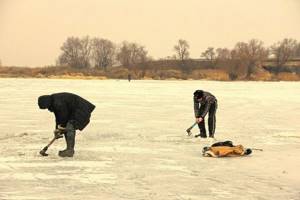
Gear and equipment for ice fishing
To install a network in winter you need to purchase:
- racing (60 m rope);
- run (pole 8-10 m);
- sewed (several 2-meter sticks with hooks to adjust the movement of the purlin in the holes in the ice);
- chainsaw to create an ice hole;
- sinker;
- net;
- torpedo (if possible, it is advisable to buy it, since installation with it will be easier);
- springy wire (if fishing is done with a scarf);
- fertilizing (can be purchased at the store or made independently).
Of course, for fishing in winter you need to take care of warm clothes, water and food, even if the fisherman leaves after installing the net. You need to be prepared in advance for the fact that placing the gear may take time.
How to manage networks in winter
It will be easier to do this in a group than alone.
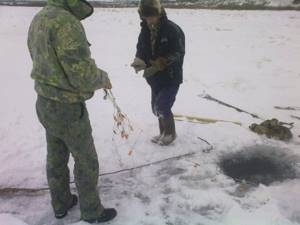
Look for places that are clear of snags. Next, several main holes are mechanically cut out with a deviation of the grid size (1 m X 0.5 m). Make the holes with a bevel at the top. Between them, cut out several control ones, smaller in size.

Available equipment for fishermen:
- stick up to ten meters;
- another one is shorter and with a grip for adjusting the process;
- durable twine for several tens of meters.
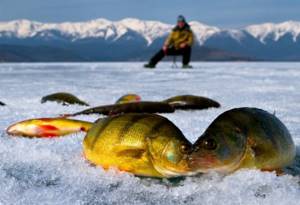
Preparation for placing nets under ice
Preparation is pre-prepared equipment for setting up nets, as well as choosing a place for drilling holes.
The application of knowledge in practice turns out to be a very complex process in many cases. When going on ice, you should once again familiarize yourself with the rules for such setting. Feedback from people who have experienced difficulties and can tell you what to do or not do will be very helpful.
How to choose a place?
The choice of location must be approached responsibly.
And for this you need:
- Know the body of water well;
- Be located closer to the center of the reservoir;
- When drilling holes under the ice, there should be no snags, algae or other obstacles to avoid damage to the nets.
Cutting holes for the network
- First, it is recommended to clear the selected area of snow;
- Using a drill or chainsaw, cut 2 holes next to each other (the dimensions should be about 0.5 meters by 1 meter);
- The edges of the holes are beveled at an acute angle to allow the nets to slide under the ice;
- Between the main holes (lanes), several more are cut, but of a smaller size (in order to control the process).
Fish loves cleanliness
It does not matter what material this or that network is made of. Even fishing in winter with nets requires cleaning them every time from the remains of everything from the river and, of course, washing them.
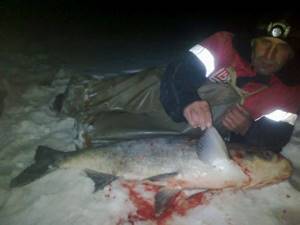
For this purpose, Karelian fishermen regularly smoke their nets with smoldering pine and spruce cones.
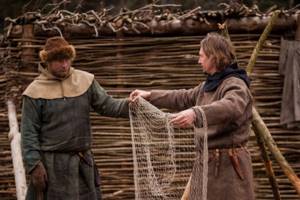
After the end of the fishing season, the net is washed, dried and hung in a shed or other utility room.
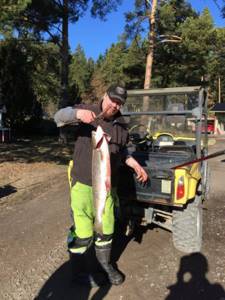
Installation of gear
There are several methods to install a network.
Standard installation
Step by step steps:
- Place a sinker on the lower section of the net so that it straightens out and does not get tangled when lowered into the pond.
- Pull the races through the top of the network.
- Tie the end of the rope to the purlin.
- Lower the run into one of the large lanes and lead it to a smaller hole.
- When he reaches the outermost lane, take him out of the water and untie him.
- Tighten the remaining portion of the mesh into the ice fishing hole using a racer.
- In the intermediate holes, tie the net to the sticks so that it does not sag. Its edges are located below the ice level so that they do not freeze.
Expert opinion
Valery Andreevich Sizov
Professional fisherman with 35 years of experience
Note! If the network is installed on a river with a current, then it must be stretched in the direction of the water movement.
Installation with torpedo
This is a special device that resembles torpedoes on warships, only it is smaller in size. Battery operated.
A rope is tied to the device, after which it is lowered into the first lane. The torpedo is sent through the intermediate holes. To determine the location, the equipment is equipped with signal lights. The torpedo greatly facilitates and speeds up the installation of the network in winter.
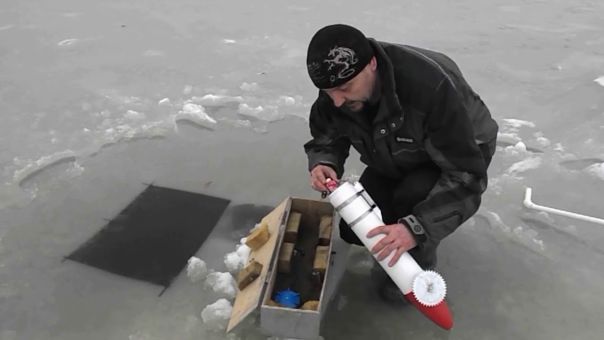
Fishing with a scarf
It has a triangle shape and is smaller in size than a regular rectangular net. Even one person can accommodate it.

Fishing method
Step-by-step steps for installing a gusset for ice fishing:
- Tie a springy wire to the base of the tackle. It will calmly pass through the hole in the ice and will additionally perform the tasks of a sinker.
- Cut a hole.
- Feed the fish through it.
- Tie the upper section of the triangle to a rope.
- Lower the bottom of the net into the hole to the maximum possible depth.
- Fix the second end of the rope, which is not tied to the tackle, to a stick placed across the hole in the ice. Wrap the excess twine tightly around it.
Expert opinion
Valery Andreevich Sizov
Professional fisherman with 35 years of experience
Note! To get a larger catch, it is recommended to install several gussets at once.
How to best place an underwater seine
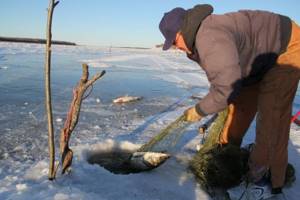
Step by step steps:
- Cut a large hole (2 by 2 meters) through which the seine will be pulled out.
- From there, cut holes in a circle at a distance of 2-3 m. A rope will be pulled through them using sticks to guide the tackle.
- The end of the net makes a circle and goes out into the hole, driving the catch into the “bag”.
- Through the wormwood, get a net with the caught fish.
Expert opinion
Valery Andreevich Sizov
Professional fisherman with 35 years of experience
Helpful information! In winter, you can also use a casting net or grabber.
What if with bait?
The websites contain advertising information about the use of some fairly effective bait. It represents the so-called “dried blood” based on the blood of farm animals. Plus synthetic pheromones. After all, a shark can feel even a drop of blood in the water kilometers away.
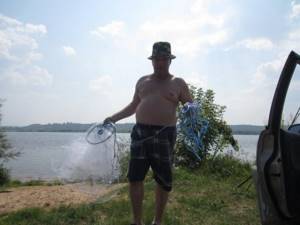
But who produces this “Dry Bluder”, there is only some reference that the country of origin is Russia. But the sales advertising is huge.
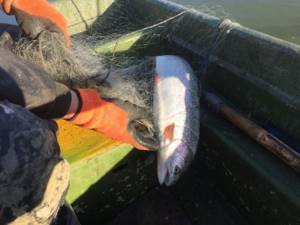
On one site there is a link to two LLCs from Chuvashia with penniless authorized capitals and with “consulting activities and work in the field of computer technology” and “construction work.” Resale?

The back of the packaging in the advertisement is shown remotely, and nothing can be seen on it.
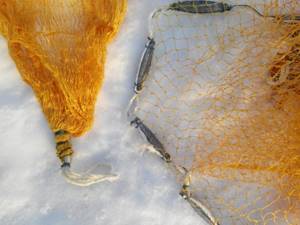
Helpful advice
In conclusion, I would like to give some useful advice. Before each installation, the network must be cleaned. Fish will not swim to a dirty net. Additionally, before fishing, you can fumigate it with pine or spruce cones.
Also, before fishing with a net, do not forget that you need to obtain a license and go only to certain bodies of water. Otherwise, such fishing will be considered poaching.
Is it worth buying a foam box for winter fishing Aelita: read the expert’s opinion in our article.
Photos of fishing with nets in winter
Help the project, share on social networks 

0
Standard method
To catch fish this way you need certain materials and tools:
- The purlin is a strong and straight pole, the length reaches up to 10 m.
- Race is the rope needed to stretch the net under the ice.
- A soshilo is a wooden stick with a hook designed to regulate a net.
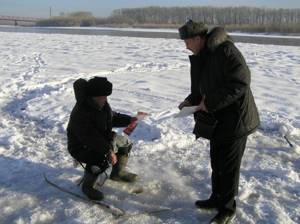
The net is installed in a similar way: a run with a rope is inserted into the first hole, to which the upper part of the tackle is attached. The lower part must be weighted with a load. The stick should move under the ice towards another lane. With the help of additional holes located between the main ones, the gear controls and corrects movement.
The run should eventually appear on the second hole. Once the network is pulled to the surface, final control over it will appear. The rope must be pulled until all the gear disappears under the ice. To control the net in the horizontal direction, it is tied to a stick laid along additional holes. To prevent the net from freezing to the ice, it is lowered slightly.
If there is a current at the place where the net is being installed, then it will be much easier to use the tackle; you won’t even need to cut down additional holes. The current will simply drag the pole with the gear to the opposite lane. But if the tackle is too long, then you can make intermediate holes, but here there will be much fewer of them.

